Domino.io Module Tips and Tricks
Some basic instructions/ramblings to get started (as the documentation for the Domino module isn’t currently complete)
To connect your Domino to a WiFi network using a GUI:
Plug in your Domino Pi/Qi/base module and use your phone or laptop to connect to the “Domino-***” Wifi. The default password is “goodlife”. Navigate to http://192.168.1.1/ to access the web interface. Change your device’s hostname and password on the web interface and click “Okay, Reset”. Reconnect using your new password, navigate again to http://192.168.1.1/ and log in using your new password, and you will have access to the web interface.
The basic interface (“Domino Web Panel”) is mobile-friendly; the “LUCI” tab, however, is still formatted for larger screens.
To connect to your local wireless network, choose “LUCI”, then “Network”, “WiFi”. Click “Scan” beside “Generic Wireless” and click “Join Network” next to your WiFi. Enter your password and hit “Submit”. Scroll to the bottom of the page and select “Save and Apply”. You can now access http://domino.local/ from your network.
To connect your Domino to a WiFi network using the command line:
Connect your domino by USB and open a terminal to it (/dev/ttyUSB0 on Linux or whichever COM port Windows assigns) at 115,200 bps. You will have root access just like any OpenWRT implementations. You will want to change the wifi-iface block in /etc/config/wireless to look something like the following (modify to suit your needs):
config wifi-iface
option network ‘wwan’
option ssid ‘yourwifinamehere’
option encryption ‘psk2’
option device ‘radio0’
option mode ‘sta’
option bssid ‘ma:ca:dd:re:ss:he:re’
option key ‘yourpasswordhere’
Mount points / Storage:
With the 3x USB + MicroSD expansion:
/mnt/sda1 is your microSD card
/mnt/sdb1 is your USB,
/mnt/sdc1 is your internal Flash storage
Getting a terminal on the Domino Qi (Arduino Yun Clone):
- Upload the YunSerialTerminal sketch over USB
- Connect to the Qi at 115200 8N1 and send ~2 to set it to 115200 (Otherwise you’ll just get garbage)
More goes here as I play around with it…

